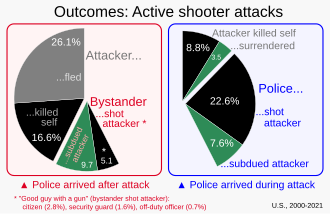Active shooter
The term is primarily used to characterize shooters who are targeting victims indiscriminately and at a large scale, who oftentimes, will either commit suicide or intend to be killed by police.
The Federal Bureau of Investigation defines an active shooter as "one or more individuals actively engaged in killing or attempting to kill people in a populated area", excluding gun-related incidents that were the result of self-defense, gang or drug violence, residential or domestic disputes, crossfire as a byproduct of another ongoing criminal act, controlled barricade or hostage situations, or actions that appeared not to have put other people in peril.
Locations are generally described as soft targets, that is, they carry limited security measures to protect members of the public.
[8][9] In the United States, the Investigative Assistance for Violent Crimes Act of 2012, passed in the aftermath of the Sandy Hook Elementary School shooting in Newtown, Connecticut, clarified the statutory authority for federal law enforcement agencies to provide investigatory assistance to the States.
[11] Pursuant to the responsibilities assigned to the DOJ by the Act, the FBI initiated a program including research into active shooter incidents and the development of training resources in support of helping national, state, and local law enforcement agencies prevent, respond to, and recover from such attacks.
[23] According to Ron Borsch, active shooters are not inclined to negotiate, preferring to kill as many people as possible, often to gain notoriety.
Few law enforcement officers have been injured responding to active shooter incidents; fewer still have been killed.
[24] As noted, more often than not, when the prospect of confrontation with responding law enforcement becomes unavoidable, the active shooter commits suicide.
For law enforcement, the tactical imperative is to respond and engage the killer without delay—the affected orthodoxy of cumbersome team formations fails to answer the rapid temporal dynamics of active shooter events and fails to grasp the nature of the threat involved.
For civilians, when necessity or obligation calls, the tactical mandate is to attack the attacker—a strategy that has proved successful across a range of incidents from Norina Bentzel (William Michael Stankewicz) in Pennsylvania and Bill Badger in Arizona (2011 Tucson shooting) to David Benke in Colorado.
[27] Still others such as Grossman and DeGaetano argue that the pervasiveness of violent imagery girding modern culture hosts the phenomenon.
